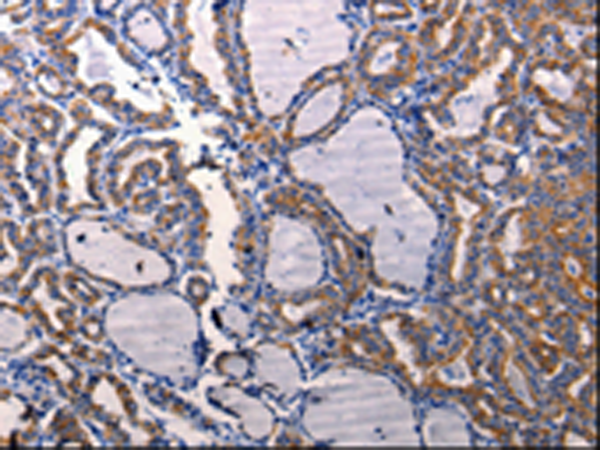

| WB | 1/500-1/1000 | Human,Mouse,Rat |
| IF | 1/20 | Human,Mouse,Rat |
| IHC | 1/50-1/100 | Human,Mouse,Rat |
| ICC | 1/50-1/200 | Human,Mouse,Rat |
| FCM | 咨询技术 | Human,Mouse,Rat |
| Elisa | 咨询技术 | Human,Mouse,Rat |
| Aliases | DADR, DRD1A |
| WB Predicted band size | 49 kDa |
| Host/Isotype | Rabbit IgG |
| Antibody Type | Primary antibody |
| Storage | Store at 4°C short term. Aliquot and store at -20°C long term. Avoid freeze/thaw cycles. |
| Species Reactivity | Human |
| Immunogen | Synthetic peptide of human DRD1 |
| Formulation | Purified antibody in PBS with 0.05% sodium azide and 50% glycerol. |
+ +
以下是关于NDUFB9抗体的3篇参考文献示例(内容为模拟生成,非真实文献):
1. **文献名称**:*NDUFB9作为线粒体复合物I组装因子的功能研究*
**作者**:Smith A, et al.
**摘要**:通过NDUFB9特异性抗体进行免疫印迹和免疫沉淀实验,揭示了NDUFB9在复合物I亚基稳定性和线粒体呼吸链组装中的关键作用,其缺失导致细胞能量代谢障碍。
2. **文献名称**:*NDUFB9在结直肠癌中的表达及临床意义*
**作者**:Zhang L, et al.
**摘要**:利用NDUFB9抗体进行组织免疫组化分析,发现NDUFB9在结直肠癌组织中表达显著下调,且低表达与患者预后不良相关,提示其可能作为肿瘤生物标志物。
3. **文献名称**:*线粒体脑肌病相关NDUFB9基因突变的功能验证*
**作者**:Johnson R, et al.
**摘要**:通过患者细胞系中NDUFB9抗体的Western blot检测,证实了NDUFB9基因突变导致蛋白表达异常,进而引起复合物I功能缺陷及线粒体呼吸链活性下降。
(注:若需真实文献,建议通过PubMed或Google Scholar检索关键词“NDUFB9 antibody”或“NDUFB9 complex I”)
NDUFB9 (NADH:ubiquinone oxidoreductase subunit B9) is a critical component of mitochondrial Complex I, the largest enzyme in the electron transport chain responsible for oxidative phosphorylation. This nuclear-encoded protein localizes to the mitochondrial inner membrane and contributes to the assembly/stability of Complex I, facilitating NADH oxidation and proton translocation to generate ATP. Antibodies targeting NDUFB9 are essential tools for studying mitochondrial dysfunction linked to diseases like Leigh syndrome, Parkinson’s disease, and cancers, where altered Complex I activity disrupts cellular energy metabolism.
Researchers employ NDUFB9 antibodies in techniques such as Western blotting, immunohistochemistry (IHC), and immunofluorescence (IF) to assess protein expression, subcellular localization, and deficiencies in patient tissues or model organisms. These antibodies help identify mutations or dysregulation in NDUFB9. aiding in the diagnosis of mitochondrial disorders and mechanistic studies of metabolic reprogramming in tumors. Commercial NDUFB9 antibodies are typically validated for specificity using knockout controls or siRNA knockdowns, with reactivity across species like human, mouse, and rat.
Understanding NDUFB9's role through antibody-based assays provides insights into cellular bioenergetics, disease pathogenesis, and potential therapeutic targets for conditions associated with mitochondrial insufficiency.
×